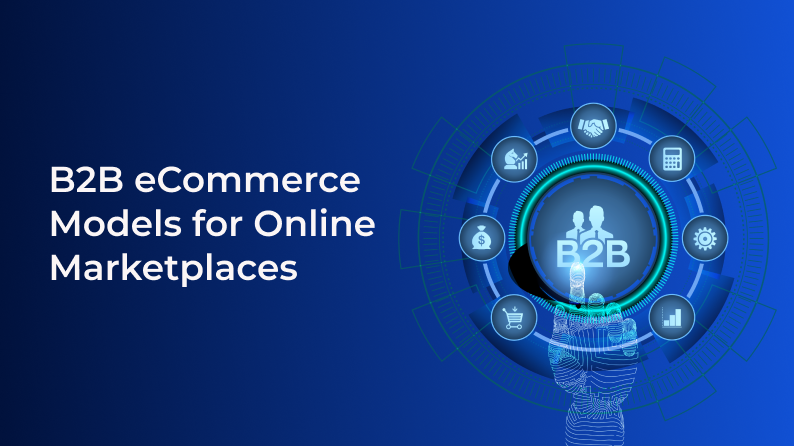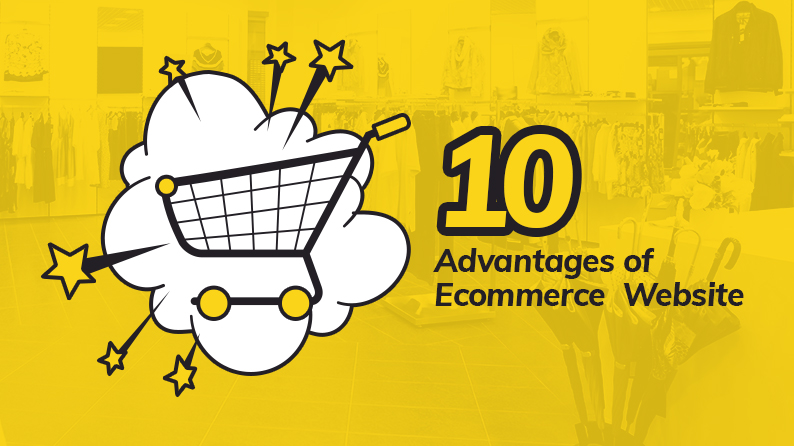Updated On: 1st April 2024
Led by the likes of Alibaba, the B2B industry is undergsoing a transformation. eCommerce brings multiple benefits to the table, and it was only a matter of time till businesses across industries started to favor online commerce over traditional sales channels.
Naturally, the sector offers a sea of opportunities for aspiring entrepreneurs to start their B2B eCommerce business. That said, unlike B2C eCommerce, B2B is more complex, and there are multiple ways to cater to the requirements of businesses via eCommerce platforms.
So even though Alibaba is one of the biggest names in the industry, it’s not the only way a B2B eCommerce platform works. This is where understanding B2B eCommerce business models can help you in identifying new opportunities in this domain. Let’s dive in.
Table Of Contents
What is the difference between B2B eCommerce models?
Let’s take a product like a fashion garment. The supply chain for this product has suppliers, fabricators, and others – involved during various stages of the product reaching the buyer. These businesses are spread across the globe. Consumption markets driving the demand are primarily Western countries led by the US. While fabrication sources are in Asian countries like China and Bangladesh.
Here the entrepreneurs can have two options for structuring the B2B eCommerce model of their business: Either they can start an eCommerce marketplace that allows retailers or wholesalers in the US to source products from manufacturers in Asia, or they can start a marketplace that allows the buyers to float tenders for their requirement. Interested fabricators can connect and supply the required products.
In the former eCommerce business model, the demand side is connected with the supply while it is vice versa for the latter case. These are just two examples in many other possible scenarios. Let’s discuss all below.
What are the different Types of B2B eCommerce Business Models
CATEGORY 1: Based on the Architecture of the Marketplace:
A B2B marketplace has three participants – Buyers, Sellers, and the admin. The architecture of the marketplace can vary depending on the roles that these three have on the platform. The following three are the possible B2B eCommerce models based on the architecture.
1. Supplier Oriented Model (eDistribution)
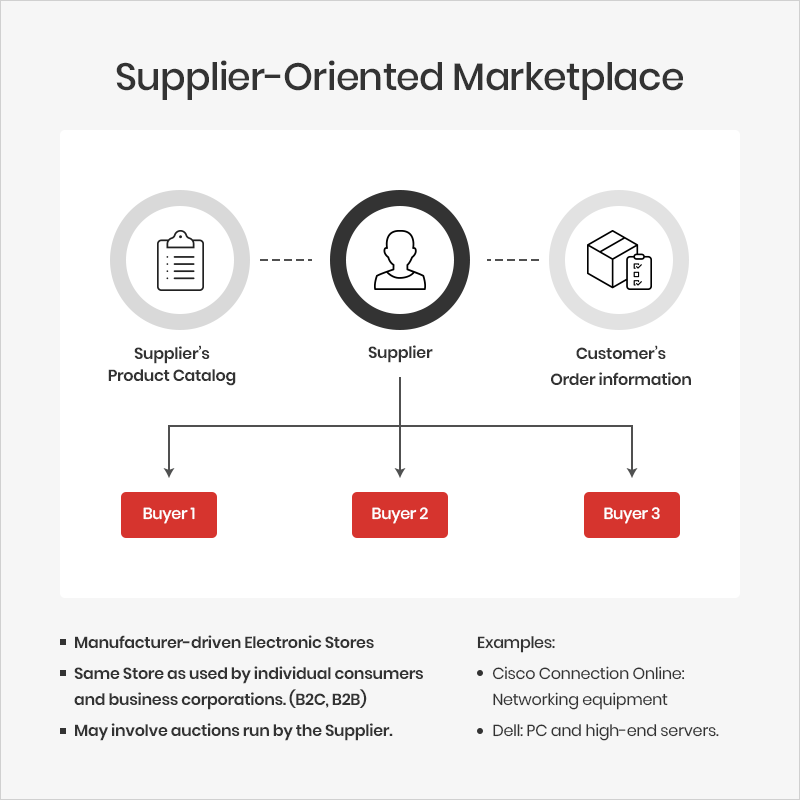
In a supplier-oriented model, several suppliers collaborate to set up an online B2B marketplace. The platform serves as an efficient channel for these suppliers to sell to a large number of businesses. They list their products or services and set up the operational infrastructure of the marketplace business.
The buyers search through the sellers, and their offered products/services. Select a desired commodity and complete the transaction. In such a marketplace business, the operations are managed by an Admin assigned by the sellers. For an eDistribution to be successful, the loyalty of businesses and goodwill in the market is crucial.
Popular supplier-oriented B2B marketplace in the industry:
Cisco Connection Online is a B2B marketplace by Cisco. It invites partners as resellers or suppliers on the marketplace. It offers a wide range of products and services on the platform.
Start Your Own E-Commerce B2B Marketplace
2. Buyer Oriented Model (eProcurement)
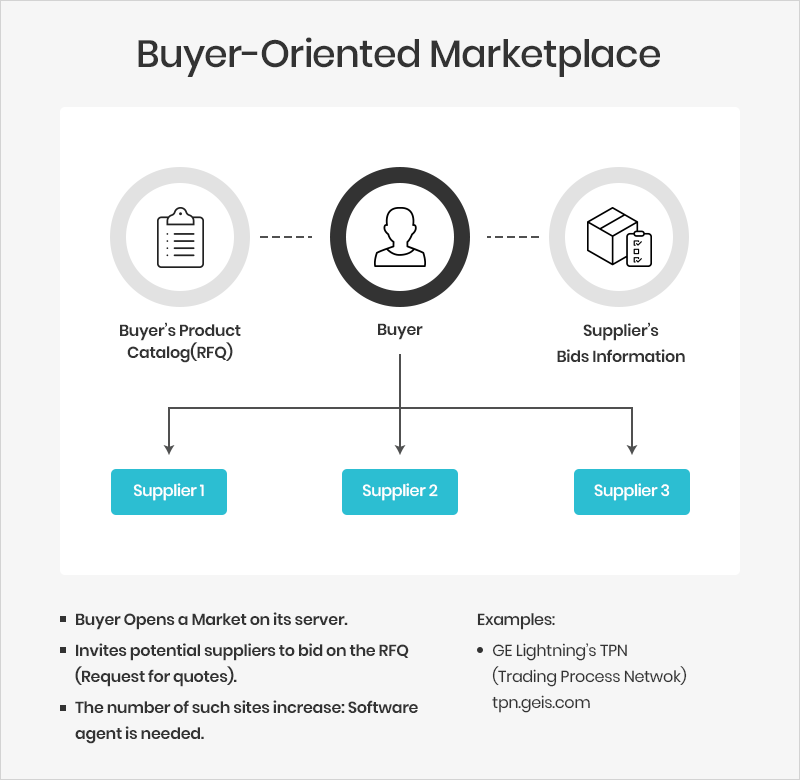
Also known as a “sourcing portal”, eProcurement is a B2B eCommerce model that facilitates buyers in posting their needs. These can be in the form of invitations for bids or proposals, tenders, or a fixed price range for the desired product or service. Once the quotes start to flow in, the buyer can carefully analyze the quotes and decide which seller to transact with.Since this B2B model in eCommerce marketplaces centers around the demands of individual buyers, it helps to bring down their administrative costs and also get the best price from the suppliers. This business model is plausible for either big corporations with greater purchasing power and high volume purchases or simply entrepreneurs considering to launch a B2B marketplace that emphasizes the buyers’ needs.
Popular eProcurement player in the industry:
GE’s electronic bidding site, known as GE TPN Post acts as a buyer-oriented marketplace. To use this site, the buyers need to pay a nominal fee. Post that they can share their project requirements on the website. Suppliers who can meet the requirements start making bids for the project. Once there are plenty of bids to choose from, buyers can go ahead and decide which one gives them the best bang for their buck.
3. Intermediary-Oriented Marketplace Model (eExchange)
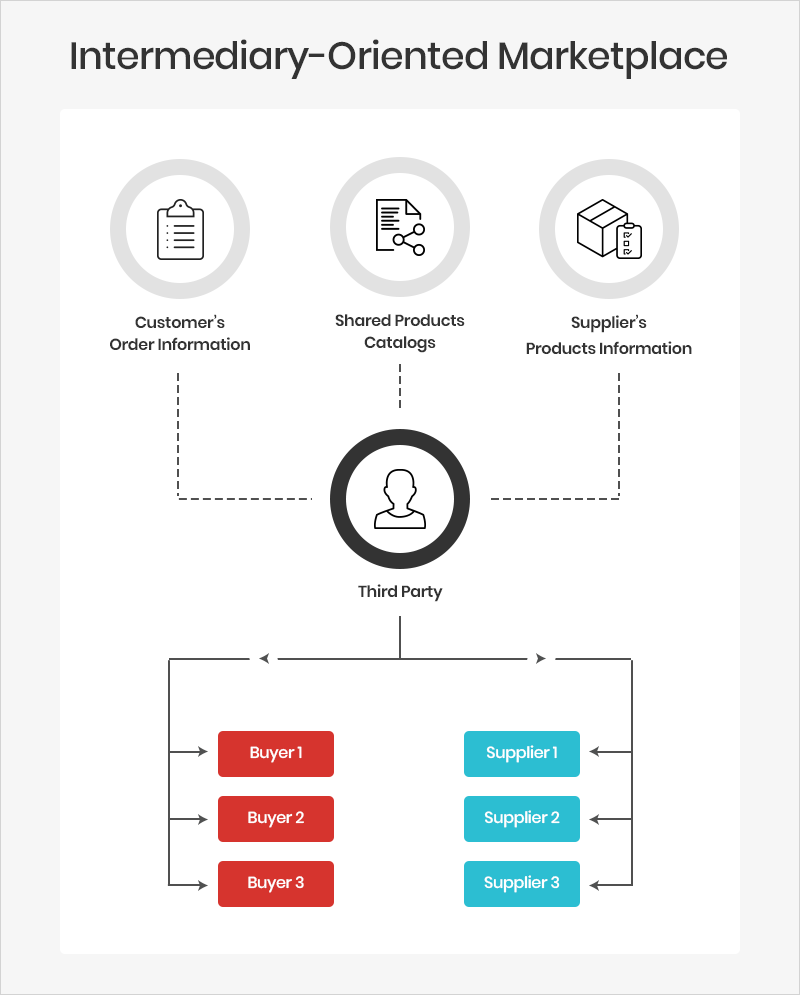
An intermediary-oriented B2B eCommerce model allows sellers to sell their products and services to buyers on a platform managed by an intermediary. Apart from management, here the role of the intermediary is providing backend support for eCommerce operations. This can include shipping, accounting, technological infrastructure management, and others. For this, they earn revenue by way of commissions, subscription services, advertisements, and others.
Popular intermediary-oriented B2B marketplace in the industry:
Typical examples of intermediary-oriented B2B marketplaces are popular eCommerce marketplaces like Alibaba, eWorldtrade, and Amazon Business. However, the business model can be shaped in addition to the above-stated considerations. Let’s continue with the second category of B2B eCommerce models below.
CATEGORY 2: Based on the Service Industry:
Let’s analyze how the B2B models in eCommerce can be shaped according to the industry the marketplace is built to serve.
1. Horizontal Marketplace Business Model
A horizontal B2B eCommerce business model will cater to a wide variety of products and services across industries. It has a wider scope for marketplaces, so has more potential to scale and drive in volumes. These volumes will further complete the cycle for the business to drive home its USP of greater value, more competition amongst sellers, a wide range of products, and so on. Alibaba is an example of a horizontal B2B marketplace.
2. Vertical Marketplace Business Model
A vertical B2B marketplace focuses on a specific industry. For instance, a B2B platform just for fashion products or one starts an eCommerce Pharmacy marketplace. By doing so, they narrow down their target audience making it relatively easier to purpose-driven marketing strategies, and offer the target audience a tailored value proposition. UNI Diamonds, Procurenet, and SupplyHog are examples of vertical B2B marketplaces.
CATEGORY 3: Based on the Commodities Offered:
Since the turn of the century, manufacturers and distributors have realized the economics of venturing downstream of the value chain. Hence they identify more opportunities to drive revenue apart from their core business. In the third category, we focus on commodities being offered on the marketplace platform.
1. Offering Products Exclusively
The first option is setting up a platform where just products are offered. Here the B2B marketplace can focus on connecting the demand with the supply of products. For instance, a fashion marketplace that connects manufacturers, distributors and other suppliers directly with retailers orwholesalers. This business model can be ideal if the services for the product are either not required or are easily available via offline channels.
2. Offering Services with Products
The second B2B eCommerce business model is when a business offers both services and products on its platform. For instance, Procurenet, a B2B Pharmacy marketplace offers both products in the form of medical equipment and services from Contract manufacturers in the domain.
Just like the pharmacy industry, in many more industries, allied and after-sales services account for a larger revenue share. So, depending upon the operative niche of the marketplace, offering services alongside products can facilitate the sellers in offering added value to the buyers, and help in broadening the horizon for the business.
Build Service and Product Based Marketplace
3. Networking Marketplaces
Consider the example of India-based B2B networking marketplace – IndiaMart: It simply acts as a digital middleman, connecting buyers and sellers. After submitting an RFQ form for a product they are interested in, buyers get a list of sellers along with contact details. This implies that the buyers can contact the sellers outside of the marketplace if they so desire.
The reason behind the viability of this marketplace business model is the lack of offline marketing capabilities for B2B sellers. Such platforms enhance their visibility and help them to reach a wide audience. For the marketplace owners, subscription plans or/and listing fees are significant revenue streams.
This marketplace business model is attracting legacy B2B sectors like finance, crowdfunding, real estate, and outsourcing.
Suggested Read: Top 5 B2B eCommerce Platforms to Build B2B Online Marketplaces
Multiple B2B e-commerce models means opportunities
The digitization mandate is opening up opportunities in the online space, making digital sales channels both lucrative and imperative for businesses.
That said, the B2B space is distinct and laden with complexities. Purchase decisions are research and ROI-driven – with longer sales cycles and an emphasis on business relations between the buyer and the seller.Because of this, there are multiple examples wherein B2B space is transitioning with a fresh perspective by coalescing and evolving business models to align with the transformative shift in the industry. Thus, the future of B2B eCommerce is likely to be innovation-driven – both technologically and operatively. To benefit from the rising opportunities, new B2B marketplace prospects will need the requisite versatile tools. This is where Yo!Kart B2B comes into the picture.
Explore Yo!Kart B2B Ecommerce Platform in Action
To Sum It Up
The B2B space is opening up for new opportunities. Entrepreneurs or enterprises can analyze the possible B2B eCommerce model variations mentioned in this blog and strategize their launch.
Each model is designed to address some very specific needs of B2B businesses in the present times and the years to follow. For instance, the buyer-oriented model allows buyers to set up their own website, post their requirements, and initiate transactions.
On the other hand, in a supplier-oriented multi-vendor marketplace, the suppliers set up the website to establish an online sales channel. An intermediary-oriented marketplace model is set up by an intermediary connecting a large number of buyers and sellers. The owners of this model earn profit from successful transactions.
So it’s clear that each B2B eCommerce marketplace model is designed with a purpose. Instead of wondering which B2B marketplace would reap the maximum profit, the question entrepreneurs need to consider is what type of role would best suit the identified industry.
For most popular B2B eCommerce models, the versatile Yo!Kart B2B can be an ideal solution to power your business idea.
FAQs
Q.1 Are marketplace business models in B2B different from those in B2C?
Ans. Yes, the users in B2B domain vary distinctly from those in B2C. B2B marketplace platform connects businesses across the supply chain i.e. raw material suppliers, manufacturers, distributors, wholesalers, resellers, retailers, and more, while for B2C marketplaces its just end customers. This difference in target audience means that the users’ needs, interests, sales process, and other elements vary greatly. (For more information read this.) Hence marketplace business models vary for B2B than B2C.
Q2. How to pick the best-fit B2B model in eCommerce?
Response: Yes, B2B eCommerce varies distinctly from B2C. The users are unique, follow distinct sales processes, and have exclusive set of priorities. Hence one needs to build an eCommerce platform considering all B2B eCommerce idiosyncrasies.
Q3. Is there any readymade software available for B2B needs?
Response: Yes, there are readymade software available in the market to launch B2B marketplaces, although these vary among themselves with their own strengths and best uses.
For instance, Yo!Kart B2B is a purpose-built solution to launch a B2B marketplace with key B2B features to drive success.
